
|
|
|
|
 |
|
Home Site Search Contact Us Subscribe
|
|
|
|
Fine Tuning: Utah State University Performance Hall by Sasaki Associates
Logan, Utah: Inspired by the surrounding mountains, a new building establishes a campus arts precinct that bridges the town/gown divide. by ArchNewsNow August 8, 2006 With its opening in January 2006, the new, 420-seat Manon Caine Russell and Kathryn Caine Wanlass Performance Hall at Utah State University brings world-class architecture and acoustics to Logan, a quiet college town in predominately rural northern Utah. Designed by Sasaki Associates of Boston, the hall is only the first step in an envisioned School of Arts master plan, also prepared by Sasaki, for the eastern portion of campus that will bolster the school's reputation as a leading arts institution in the Intermountain Region.
The 20,000-square-foot, $10.5 million hall features sculpted, geometric forms that evoke the look of the surrounding mountains. "This building is located at an important edge of the campus," explains Vinicius Gorgati, AIA, a principal with Sasaki and the hall's chief designer. "It is also the first building within a completely new arts precinct. It needed to be dramatic, but in a way that responded to an exquisite natural setting."
A zinc panel-coated entrance pavilion has origami-like folded volumes that suggest a melding of the man-made and the natural – precise architectural geometry that also recalls primordial tectonic forces that formed the surrounding Bear River Mountains. By day, triangular skylights angle light into interior spaces; at night the pavilion faces an outdoor piazza and is dramatically lit, highlighting playful splayed columns in a pattern suggesting musical notes.
Collaborating with Artec Consultants, Inc., New York City-based theater acousticians, Gorgati conceived the 50-foot-high octagonal main space as a "second universe" cut off from outside sound while offering a wide array of "adjustability" depending on the type of musical performance and the number of occupied seats at any given time. The 18-inch-thick concrete walls are augmented by multiple layers of drywall and a final veneer of warm-colored beech wood which wraps the interior space. All mechanical systems are suspended on pads or springs to avoid the slightest vibration or extraneous sound.
To lend a sense of procession and ritual consistent with the university's serious commitment to arts education, Sasaki's Landscape Architecture group conceived an entry precinct lined with native trees and a series of pea stone fields that lead from one of the main campus portals into the new piazza.
Future plans for the School of Arts include replacing either parking lots or outmoded buildings with a new Black Box Theater, Theater Workshop Building, and School of Arts Administrative Building. Also planned is the expansion of the Nora Eccles Harrison Museum of Art – which will occupy the piazza directly across from the new performance hall – as well as extensive renovation of the university's two other music performance venues, Morgan Theater and Kent Hall.
"When completed years from now, this new School of Arts will take advantage of the dramatic drop-off in the topography and will offer spectacular mountain views, while also giving a recognizable, beacon-like physical presence to the university's arts programs," Gorgati says. The new performance hall was made possible by a gift from sisters Manon Caine Russell and Kathryn Caine Wanlass, both alumnae of the university and long-time USU benefactors.
Project Credits Master Planner, Design Architect, Landscape Architect, Civil Engineer: Sasaki Associates, Boston, MA Project Team: Ricardo Dumont (Principal-in-Charge), Vinicius Gorgati, AIA, Scott Smith, AIA (Design Principals), Elke Berger, Neil Dean, Noy Hildebrand, Paul Kempton, Assoc. AIA, Tae Yeon Kim, Willa Kuh, Katia Lucic, AIA, Oswaldo Palencia, Brad Prestbo, AIA, Katie Raymond Associate Architect: GouldEvans, Salt Lake City, UT Acoustics: Artec Consultants, New York, NY Lighting: Horton Lees Brogden Lighting Design, New York, NY Structural Engineer: Reaveley Engineering, Salt Lake City, UT MEP Engineer/Audio Visual/Fire Safety: Spectrum Engineers, Salt Lake City, UT Associate Civil Engineer: Cache Landmark Engineering, Logan, UT Builder: Jacobson Construction, Salt Lake City, UT Photography: Robert Benson Photography
Founded in 1953 by Hideo Sasaki, Sasaki Associates is an international, interdisciplinary firm of more than 270 professionals engaged in virtually every aspect of the built environment. In addition to being a leading campus planning organization, the firm designs award-winning buildings for academic and civic institutions. Sasaki is currently engaged in urban master planning throughout the United States and in Europe, the Middle East, and Southeast Asia, including a competition-winning proposal for the Olympic Green, the main site of the 2008 Beijing Olympics. The firm has offices in Watertown, MA, outside of Boston, and in San Francisco.
|
(click on pictures to enlarge) 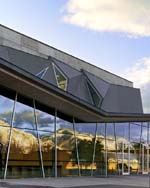 (Robert Benson Photography) Utah State University’s new Performance Hall takes its inspiration from the surrounding mountains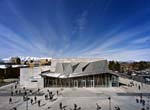 (Robert Benson Photography) The hall faces an expansive piazza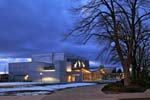 (Robert Benson Photography) A row of native trees forms a procession path from a main campus entrance to the piazza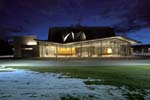 (Robert Benson Photography) The hall is aglow at night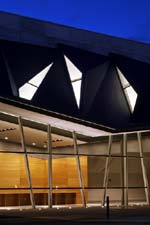 (Robert Benson Photography) Splayed columns in the glass entrance façade have a playful geometry suggesting musical notes; triangular skylights are formed by the precise geometric folding of the zinc roof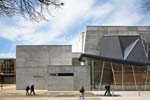 (Robert Benson Photography) Poured-in-place concrete has aggregates matching surrounding mountain geology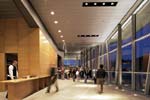 (Robert Benson Photography) Main lobby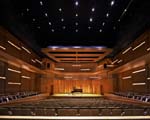 (Robert Benson Photography) The hall’s interior is clad in warm beech wood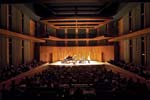 (Robert Benson Photography) Retractable side panels offer acoustical adjustability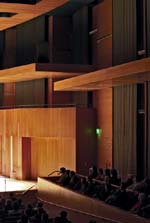 (Robert Benson Photography) Hall detail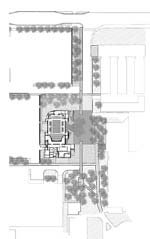 (Sasaki Associates) Site plan showing new arts piazza to right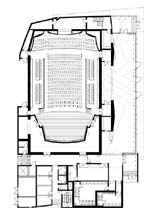 (Sasaki Associates) Floor plan |
© 2006 ArchNewsNow.com